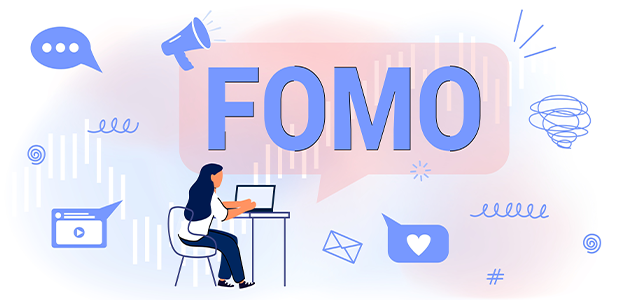
Why aren’t they buying? The secret power of FOMO in startup marketing
We’ve all seen that: great product, strong team, yet no people who are buying. In the UK, the average e-commerce conversion rate floats around 2.5% to 3% (as of late 2023 to early 2025). That means just two or three out of every 100 visitors actually make a purchase.
You can have stunning visuals, compelling copy, and generous discounts, and still end up with a low conversion rate. Why so? The point is in the emotional response, with FOMO (or the Fear Of Missing Out) leading as one of the most powerful triggers in marketing.
Data shows that 69% of UK millennials make purchases influenced by FOMO, and campaigns that strategically use this trigger now account for up to 60% of total sales, especially during seasonal offers and limited-time drops. In this article, Flowwow’s Brand Director Irina Tatarinova is delving into the nature of FOMO marketing with its growth possibilities.
What is behind FOMO marketing?
FOMO is a psychological reaction to the idea of being excluded from something important, unique, profitable. It taps into deep emotional responses, often pushing consumers to act fast to avoid ‘missing out’.
Neuromarketing studies show that when people see that something is time-sensitive (limited stock, flash sales), their brains release dopamine, which intensifies the desire to buy. Consumers get even more FOMO’s once they see others' reviews, ‘sold out’ tags, countdown timers, long queues. These social cues signal popularity, create a sense of belonging, and trigger the fear of social exclusion or missing a one-time chance, tempting customers to join. FOMO marketing performs especially well across high-traffic digital channels – landing pages, email campaigns, social media, and push notifications – all ideal for delivering urgency at scale.
FOMO marketing meets startup
It’s important to use FOMO responsibly in order to create a perfect mix of urgency and transparency that helps to build long-term relationships with customers without manipulation. Research from the University of Portsmouth shows that FOMO-based messaging can lead to compulsive spending and financial pressure. Here’re five key words on how to use fear of missing out without compromising trust of your audience.
Scarcity plus FOMO can increase sales by up to 60%, but it’s extremely important to remember about authenticity so as not to shatter trust. Nike often collaborates with designers and celebrities, limiting such drops in quantity and time.
Urgency with its countdowns and low-stock alerts is another way to use FOMO in your marketing strategy to see the rise of conversion rates. Roughly 35% of UK shoppers admit they feel like under a spell once they see time-sensitive deals. Platforms like ASOS, Platinumlist, and Boohoo pair timers with personalised notifications, increasing sales without overwhelming users. WooCommerce sites have also embraced plugins, which show real-time purchase activity and boosting conversions by up to 15%.
Validation matters – especially when it comes to social proof. Displaying reviews, testimonials, and live purchase data increases credibility and makes it easier for customers to make a purchase decision. Shopify’s homepage highlights the number of businesses using its platform and total sales processed, creating immediate confidence for new users.
Exclusivity is also on the top list of triggers. Unique personalised offers based on the purchasing history, members perks, ‘first dibs’ access make customers feel like insiders. When offers are time-sensitive and unlikely to return, the urge to stay informed – and not miss out – becomes even stronger. Uber offered a luxury experience during the release of the film Ferrari, exclusively for Uber One members. The FOMO factor was high, and the campaign drove over 20.000 rides and a viral buzz in social media.
Risk of loss drives more than a chance of a potential profit. When people feel they might miss something special, they act faster. Flowwow’s Peonymania translated the fleeting popularity of peonies into a full-on seasonal occasion to drive sales.
FOMO pitfalls to avoid
Used right, FOMO marketing can drive results. Used poorly, it can lead to some serious problems.
Aggressive behaviour, unethical pressure, or misleading can seem like manipulation and harm your brand’s reputation. Instead, communicate authentic value and make the emotional moment feel special. For example, at Flowwow, sales of rare peonies are focused around their fleeting beauty and not-so-long availability, thus inviting customers to catch the moment.
False scarcity is a sure way to damage trust. Artificially limiting availability may create initial hype, but it rarely builds long-term loyalty. Prime Hydration UK launch attracted lots of attention through scarcity-led marketing, with limited stock and viral queues. But later, demand collapsed by over 50%. The hype wasn’t supported by sustained value, leading to consumer fatigue and brand backlash.
FOMO cannot compensate for a poor product. The Willy Wonka Experience was expected to be a special magical adventure, but in fact customers faced a poor organisation promoted thanks to an AI-generated reality. As the result, public outrage, social media mockery (#WonkaGate), event shutdowns, and full refunds.
FOMO marketing isn’t about magic or manipulation – it’s about capturing attention, telling a compelling story, and inviting your audience to be part of something special.
For more startup news, check out the other articles on the website, and subscribe to the magazine for free. Listen to The Cereal Entrepreneur podcast for more interviews with entrepreneurs and big-hitters in the startup ecosystem.

